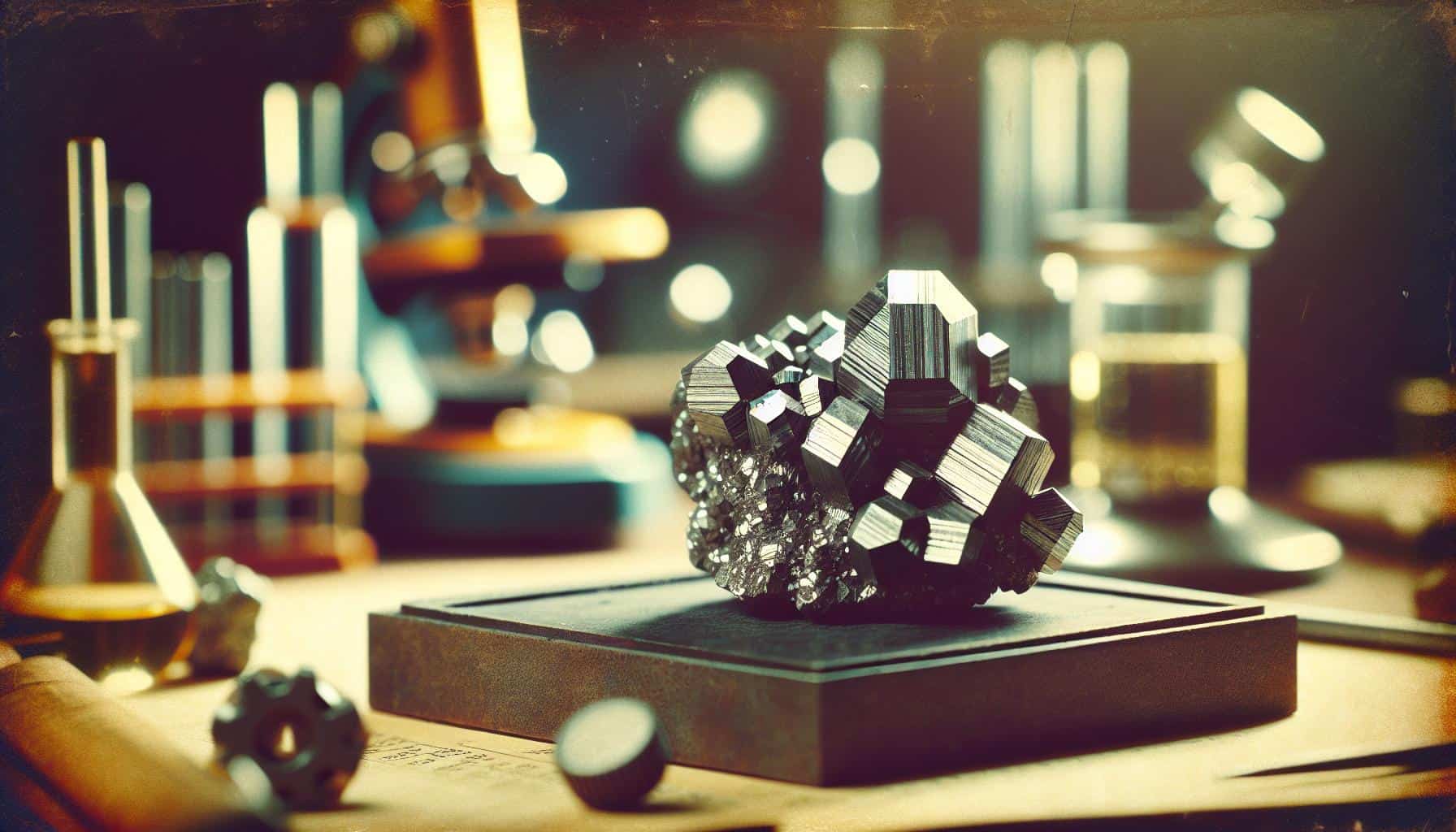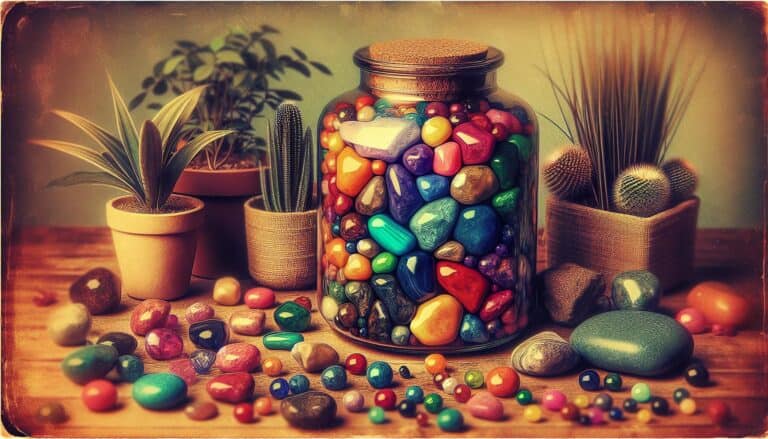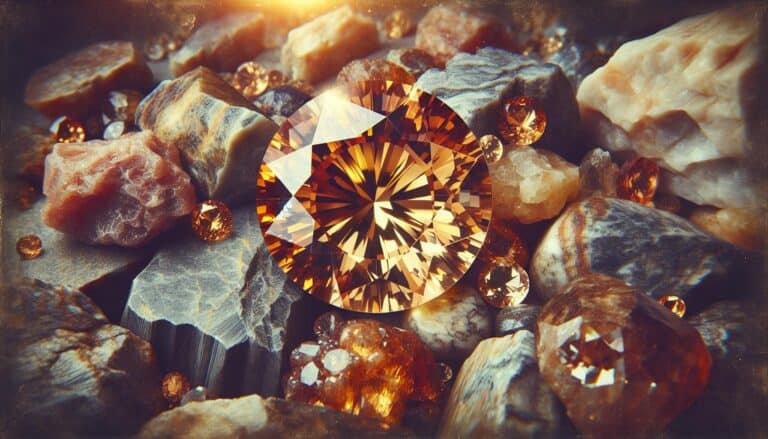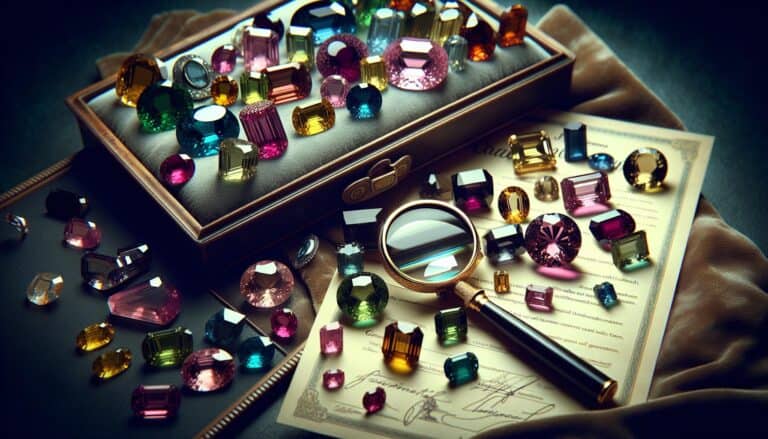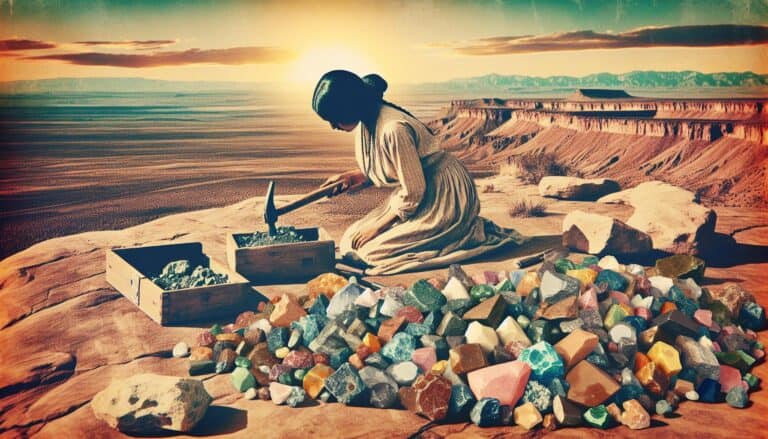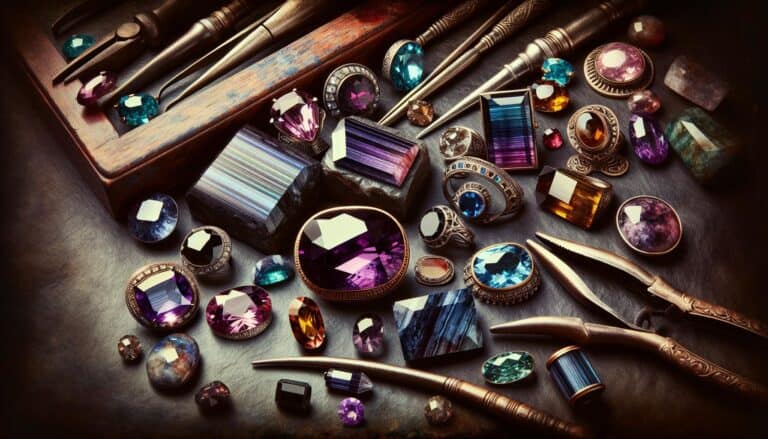Ever stumbled upon a shiny, gold-like mineral and wondered if you’ve hit the jackpot?
That’s pyrite for you, often dubbed ‘fool’s gold’ for its deceptive appearance. But don’t let the nickname fool you; pyrite has its own unique worth in the market.
Understanding pyrite’s value involves more than just its glittery facade. It’s about rarity, uses, and the intrigue it holds for collectors. You’re about to dive into the factors that determine how much pyrite is really worth.
So, keep your eyes peeled as you learn to navigate the fascinating world of this golden impostor.
Pyrite’s value depends on color, clarity, cut quality, and rarity. Vivid color and distinct crystal formations increase worth. Market demand and availability also impact prices. For buying, prioritize reputable sellers and seek certification for authenticity. Well-formed, unique specimens, especially from renowned locations, are more valuable.
What Is Pyrite?
When you’re diving into the value of pyrite, it’s essential to get acquainted with what pyrite actually is. Commonly known as fool’s gold, pyrite is an iron sulfide mineral characterized by its metallic luster and pale brass-yellow hue, which sometimes resembles gold. However, unlike gold, pyrite is ubiquitous and found in many parts of the world in various geological formations.
Pyrite’s composition includes a combination of iron and sulfur, forming its distinguishing cubic crystals that can also appear in other shapes, like an octahedron. This mineral typically forms at high and low temperatures in a variety of geological environments, making it a frequent find in igneous, metamorphic, and sedimentary rock. Owing to its sulfide nature, when exposed to air and moisture, it can oxidize and cause staining or even degradation to other minerals and geological samples.
Besides its iconic look, pyrite has several industrial uses. It’s been used in the production of sulfur dioxide for sulfuric acid, which is an essential chemical in various industrial processes. In historical contexts, pyrite was utilized to create sparks for starting fires and was a vital component in early firearms. It also holds significance in the field of crystal healing, where it’s believed by some to attract wealth and protection.
Within the realm of mineral collecting, pyrite specimens are sought for their unique shapes, aesthetic appeal, and their perfection in terms of crystal development. High-quality samples with well-formed crystals and minimal damage can be quite valuable to collectors. Sizes and shapes play a significant role in determining a specimen’s value—larger and more distinctive formations can fetch higher prices.
As you look deeper into the characteristics and uses of pyrite, you begin to understand why it’s more than just a gold imitator. It has its own place in both the practical and collectors’ market, anchoring its value beyond mere appearance.
Pyrite Prices: Factors That Affect Value

When you’re looking to gauge pyrite’s worth, it’s important to understand the different variables that can influence its value. These factors range from physical characteristics of the mineral itself to broader economic elements. Let’s break down what exactly might cause the price of pyrite to fluctuate.
Color, Clarity, and Cut Quality
The appeal of pyrite often lies in its visual properties and how well those properties are presented.
- Color: The typical brass-yellow color that resembles gold has a direct impact on pyrite’s value. Stones with more vibrant and consistent hue are sought after more, and thus, might fetch higher prices.
- Clarity: While pyrite is not valued for transparency as gemstones are, the presence of inclusions or other imperfections can detract from its overall luster and decrease its value.
- Cut Quality: The proficiency with which pyrite is cut can enhance its natural beauty, which can in turn influence its desirability. Well-cut pieces, particularly those fashioned into attractive shapes or fine specimens, can be more valuable.
In the realm of mineral collections, the perfection of these properties is paramount, and high-quality specimens often command premium prices.
Market Demand and Availability
Market dynamics play a significant role in determining the value of pyrite.
- High market demand for pyrite, especially for industrial purposes, can increase its value. When industries reliant on pyrite are booming, the demand for this mineral can drive up prices.
- Availability is another significant factor. Abundant resources may lower the cost, while rarer specimens of pyrite, especially those from specific localities known for exceptional quality, might be priced much more steeply.
It’s important to keep in mind that local economic conditions, the cost of extraction, and the scalability of production also contribute to defining the market value of pyrite. In regions where extraction is easier and less costly, prices might be lower compared to areas where the mining process is complex and expensive.
Keeping up with industry trends and maintaining an awareness of market shifts can be beneficial if you’re looking to invest in pyrite or add to your mineral collection.
Understanding Pyrite: A Rare Gem

The Rarity of Pyrite
Pyrite, often nicknamed ‘fool’s gold,’ is more common than true gold but still holds a unique place in the gemstone market. Contrary to what the nickname suggests, you’ll find that pyrite’s rarity stems from its crystalline perfection rather than its abundance. Quality specimens are coveted by collectors and enthusiasts alike, especially those that exhibit well-formed cubic crystal structures. Indeed, it is the allure of these naturally formed geometric marvels that often enhances their worth.
Mining locations are scattered globally, with high-grade pyrite originating from countries like Peru, Italy, and the United States. The availability of these quality pieces can fluctuate, leading to periods where the gem is less accessible on the market, driving up its desirability and value.
Origins and Characteristics
Diving into the origins and characteristics of pyrite, you’ll find it’s a sulfide mineral composed of iron and sulfur. What makes it particularly fascinating are its metallic luster and pale brass-yellow hue, which give it a superficial resemblance to gold. The historical incidents of mistaken identity in prospecting lore only add to its allure and narrative.
- Pyritohedral crystals
- Cubes
- Octahedral forms
Each variety presents unique attributes, like striations, overgrowths, and even replacement forms, which can enchant the discerning collector. To truly appreciate the worth of pyrite, it’s essential to understand its definitive features, such as:
- Hardness (which typically ranges around 6 to 6.5 on the Mohs scale)
- Specific gravity (about 5.0, notably heavier than it appears)
- Striking crystal habit
These characteristics don’t just influence collectability; they also have practical applications in jewelry and industry. Pyrite’s ability to create sparks when struck against metal led to its use in early firearms, an interesting historical tidbit that can add to its perceived value.
Pyrite Grading and Valuation
The Grading System for Pyrite
When you’re looking to assess the value of pyrite, understanding the grading system is crucial. Grading for pyrite is somewhat similar to how gemstones are graded, and focuses primarily on three aspects: visual appeal, weight, and purity.
- Visual Appeal: A stone’s visual characteristics, such as its color consistency and brightness, play a major role in grading. Pyrite with a vibrant gold luster that closely mimics the look of real gold commands a higher grade.
- Weight: Like most minerals, pyrite is also priced by weight. Generally, it’s measured in carats (ct), and larger stones with a higher carat weight can fetch higher values, provided they also possess high aesthetic characteristics.
- Purity: The inclusion of other minerals can impact the stone’s clarity. High-grade pyrite has minimal inclusions, making it clearer and more desirable.
The grading system can be subjective, and there’s no universal standard like there is for diamonds (e.g., the 4 Cs). That’s why it’s essential to seek professional opinions when valuing your pyrite samples.
Certification and Appraisal
To obtain an accurate market value for your pyrite, pursuing Certification and Appraisal from reputable sources is important. A certified gemologist can provide official documentation attesting to your pyrite’s grade. This documentation is valuable when you’re looking to sell, ensuring you get a fair price based on current market conditions.
When seeking appraisal services, it’s wise to do your homework. Identify experts who specialize in minerals like pyrite and can give you a thorough and unbiased valuation. Here are a few pointers that can help:
- Check the appraiser’s credentials and experience. Look for professionals affiliated with well-established gemological institutes.
- Understand the appraisal process. A good appraiser will check the pyrite’s weight, examine its quality, consider its rarity, and compare it with current market prices.
Certification and appraisal do come with a cost, but they are investments in ensuring that you know your pyrite’s true worth. Keep in mind that market demand and historical values can influence both the appraisal and the actual selling price of pyrite.
Remember, with varying qualities and attributes, two pieces of pyrite can have vastly different valuations despite seeming similarities at first glance. Always approach the sale or purchase of pyrite with a clear understanding of these factors.
Current Market Trends in Pyrite Pricing
When it comes to the valuation of minerals like pyrite, staying abreast of current market trends is essential. Pyrite prices may fluctuate due to a range of economic indicators that include commodity trading and industrial demand. For instance, in the jewelry industry, the popularity of pyrite as a gemstone can reflect in its market price, with notable spikes during fashion trend cycles favoring its metallic luster.
Interestingly, pyrite is not just prized for its aesthetic appeal; its practical applications also influence its worth. It’s used in the production of sulfur compounds and as a semiconductor in solar energy technology. These industrial uses can create a steady demand, which can in turn stabilize prices. You’ll want to monitor economic reports and industry news to understand how these applications impact pyrite’s market value.
Another important aspect to consider is the emergence of synthetic alternatives. The development of lab-created pyrite can affect natural pyrite’s scarcity and consequently its market price. If the market trends towards a preference for naturally sourced minerals, your pyrite’s value could see an appreciable increase. Conversely, an acceptance of synthetic pyrite could reduce demand for the natural variant.
To get a sense of current valuations, examine auction results and online marketplaces, which can provide valuable insights into what collectors and consumers are willing to pay. Below is a simplified overview of key data points to watch:
| Economic Indicator | Impact on Pyrite Pricing |
|---|---|
| Industrial demand | Stabilizes or increases prices |
| Fashion trends | Temporarily spikes prices |
| Availability of synthetics | Potentially reduces demand and prices |
Engaging with mineral enthusiast communities and forums can offer additional perspective on market sentiment. By staying connected, you can gauge consumer behavior and collecting trends, which are pivotal in understanding pyrite’s worth at any given time. Remember, the market is dynamic, and prices today might not reflect those tomorrow—flexibility and vigilance are your allies.
The Most Expensive Pyrite
When delving into the echelons of high-value pyrite, you’ll find that specimens boasting exceptional quality and rarity command the highest prices. The characteristics that typically contribute to a pyrite’s value are its visual appeal, including luster and sparkle, and its occurrence in rare formations.
High-end collectors and enthusiasts often seek out pyrite that displays unique features, such as perfect cubic crystals or clusters of crystals that form remarkable shapes. These specimens can be deemed as collectible art, and their prices can soar depending on demand. For example, a striking pyrite “sun” specimen from the famous Sparta Illinois mines could demand significantly higher prices due to its visual uniqueness and historical mining locality.
In the realm of expensive pyrite, provenance can also play a crucial role. Specimens with a well-documented discovery story or previously owned by notable collectors may attract premium prices. Here’s a quick glance at some factors that can boost the price of pyrite specimens:
- Origin from a renowned mining site
- Distinct or unusual crystal formations
- Historical significance
- Previous ownership by eminent personalities or collectors
- Impeccable condition and preservation
If you’re considering pyrite as an investment, keep abreast of auction records. High-profile auctions have witnessed impressive bids for top-grade pyrite, reflecting its desirability among collectors. Take a peek at the following table to grasp the potential price range for coveted pyrite pieces:
| Quality of Specimen | Estimated Price Range |
|---|---|
| Exceptional | $500 – $3000+ |
| Above Average | $100 – $499 |
| Average | $10 – $99 |
It’s evident that while average pieces of pyrite may be relatively accessible, those in the exceptional category are where you’ll notice significant price disparities. Remember, the market for collectibles can fluctuate, so staying informed about current trends is essential. Regularly checking updates from mineral shows, auctions, and dealer listings is key to understanding how these factors intertwine to influence the most expensive pyrite offerings on the market.
Buying Pyrite: Tips and Recommendations
Discovering where to buy high-quality pyrite and ensuring its authenticity are critical if you’re looking to invest in this unique mineral. Here’s what you need to know to make informed purchases.
Where to Purchase High-Quality Pyrite
Local Gem Shows: A great place to start your search for quality pyrite is at local gem and mineral shows. These events often host a variety of vendors and can provide hands-on experience with different specimens.
Reputable Online Dealers: If in-person shopping isn’t an option, reputable online dealers can be a fantastic resource. Look for sellers with high ratings and positive reviews.
- Research the dealer’s return policy
- Examine customer feedback
- Check for professional affiliations
Specialty Stores: Specialty gem and mineral shops often carry high-quality specimens of pyrite. They can offer expert advice and a selection curated for various budgets and preferences.
Direct from Mines: In some cases, you may be able to purchase directly from mines or mining companies. This can assure you of the pyrite quality and provenance.
Ensuring Authenticity and Value
Certificates of Authenticity: Always ask for a certificate of authenticity when purchasing. This document should detail the specimen’s origins and confirm that it’s genuine.
Knowledge Is Power: Educate yourself on the variations in pyrite’s appearance and properties. Familiarize yourself with:
- The market price range
- Differentiation between natural and artificially enhanced specimens
Use Testing Equipment: If possible, use testing equipment to confirm the pyrite’s authenticity. Simple tests may include checking the streak color and hardness.
Expert Consultation: Consider hiring or consulting with a gemologist or mineralogist to verify the authenticity and quality of the pyrite you intend to purchase.
Conclusion: Buying & Selling Pyrite
Understanding pyrite’s value is key to making informed decisions when adding it to your collection or investment portfolio.
Remember that factors like color, clarity, and cut quality play a significant role in determining worth. Stay informed about industry trends and market shifts to capitalize on your pyrite investments. When purchasing, prioritize authenticity and quality by seeking out reputable sources and requiring certification. By educating yourself and consulting with experts, you’ll ensure that you’re getting the true value for your money.
Trust your knowledge and resources, and you’ll be well-equipped to assess the worth of pyrite accurately.

